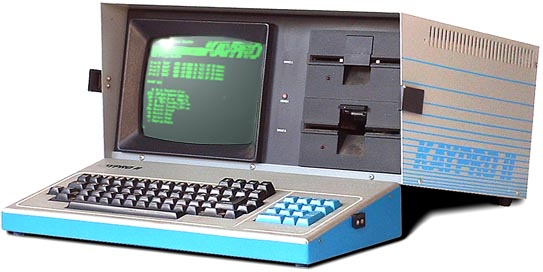I remember the incident which revolutionized my thinking about the computer. It was sometime in the 1980ies when I was talking to a secretary at Keystone Junior College in Pennsylvania. I complained to her that I was working on a dissertation and had cut up my typed pages into various snippets and was assembling them all across the floor for rearrangement. In response she went to a huge computer and proceded to “cut and paste” written material on a screen. Wow!
Shortly after, I browsed through a book on the Basic programming language, and immediately the similarity to symbolic logic hit me. Shortly after this — I think it may have been 1984 that I bought my first computer, a Kaypro, with two disc drives : one for the operating system (CP/M) and the other for data.
| Kaypro II | |
| Released: | 1982 |
| Price: | US $1595. |
| Weight: | 26 lbs |
| CPU: | Zilog Z80, 2.5 MHz |
| RAM: | 64K |
| Display: | 9″ green phosphor screen. 24 X 80 text only |
| Ports: | Serial port Parallel port |
| Storage: | Two internal 5-1/4″ SS-DD 195K drives |
| OS: | CP/M, SBASIC |

Soon I learned that there was a competitor operating system (DOS) on IBM computers, and a whole row of IBM clones was on the market. And the Kaypro company abandoned CP/M and went over to DOS.
I witnesses the emergence of the internet with a browser called Lynx (text-only), with which I learned to access a library catalog. Wow!
And then I bought an IBM clone which ran Windows 3.1, and soon came a browser from Cornell called Cello which introduces images. Wow!
Then came the web browser Mosaic in 1993 (with sound?), and the Web sprouted for me, followed by the brower Netscape, AOL, and the Internet Explorer — and here we are.
In 1990 I received my Ph.D. degree in Philosophy from Fordham University in Bronx, NY. One remark of one of the philosophers on the defense committee made a deep impression on me. He said something like this: “Too bad that such a fine dissertation will sit in the bookshelves picking up dust.”
I don’t remember the date, but I noticed that a graduate student at the University of Chicago was given space on the university’s computers for philosophical projects. I contacted him and received some space which I turned into a Wilfrid Sellars site. Soon however I purchased the domain “ditext.com” (url search reports 1998 as the year of registration) and transferred the material to this domain, giving my main web page the title “Digital Text International.”
Seeing the international reach of the internet, my ambition was to make everything about Sellars available, refusing to let my dissertation and other works “pick up dust on a library shelf.” And I was inspired to do other projects — like the Meta-Encyclopedia of Philosophy.
However, my sort of endeavor to make literature available on the internet has totally been superseded by such depositories as Wikipedia, Gutenberg, Archive.org
Since moving to Chicago in 1999, and discovering anarchism (which was never mentioned in any of my courses — ever), I have become an advocate of anarchism. And since bibliographies on anarchism, Switzerland, secession, and land rights are not sufficient to inspire readers, I decided a couple of years ago to do a Blog, in which I propagate my views. You see, while teaching introductory courses in philosophy at Wright College, Chicago, I came to realize from all my informal writings that I have ever done that my concern — private and philosophical — has always been to escape from bullshit.
